|
|
|
Voltaggio |
|
|
|
Down the valley, past the old quarry Cementir,
appears Voltaggio. |
|
|
|
|
|
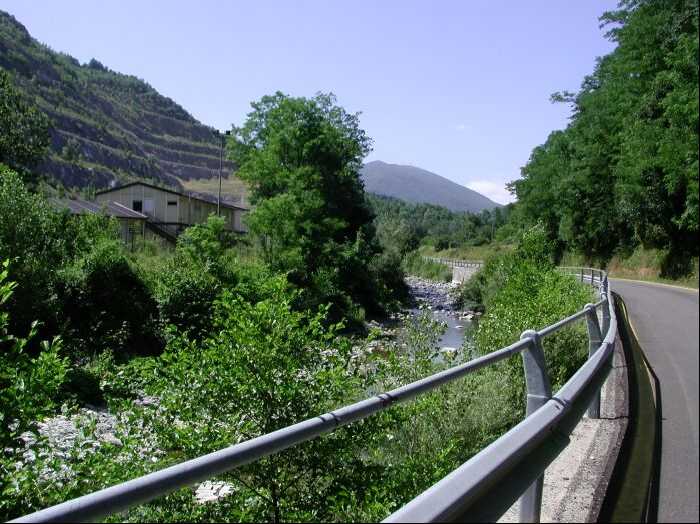 |
|
|
|
|
|
VOLTAGGIO
C.A.P .: 15060 - Tel. Code: 010 Altitude: 342 m s.l.m.
Population: 867 (about 2000 in summer)
Town Hall: Piazza Garibaldi 2 - tel. 9301214
Association PRO LOCO - c / o Town Hall
Distance from Gavi: about 10 minutes by car
|
|
|
|
|
|
Voltaggio appears today as it came to be after the
fires of 1625. The oldest part is the one that is located near the
medieval bridge at the confluence of the Lemme and Morsone. |
|
|
|
|
|
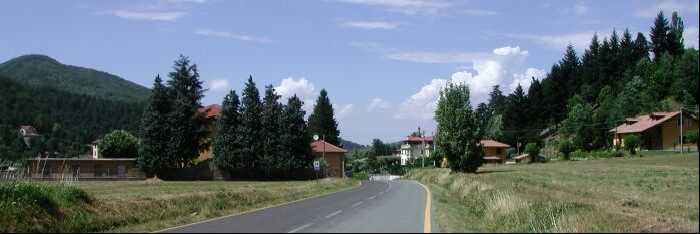 |
|
|
|
|
|
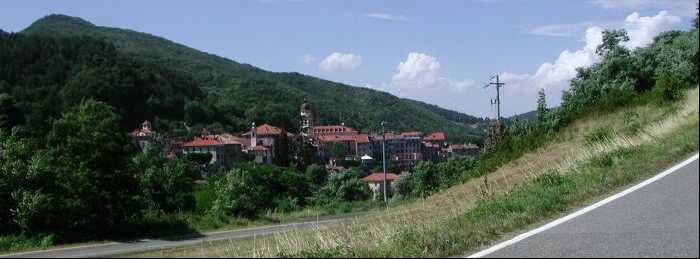 |
|
|
|
|
|
At the bridge, said Pagani or Paganini, flowed met
the two streets of the Bocchetta pass and Fraconalto and the duty border.
No coincidence that the house of Grimaldi, tax contractors on behalf of
the Republic, stood not far away. This house, now miraculously intact up
to us, is a short walk from sulfur water springs and is the oldest
residential use of Lemme valley, and a rare example of Genoese
architecture of the '400. The building therefore has a well-defined
historical significance and architectural structure very valuable for
that mixture of rustic touches, together with other more refined and
aristocratic town's technique. Extremely light are the original
Gothic windows at the top and the small niches above the cornice,
abnormal in each group than the others, perhaps to accommodate
decoration during the holidays. |
|
|
|
|
|
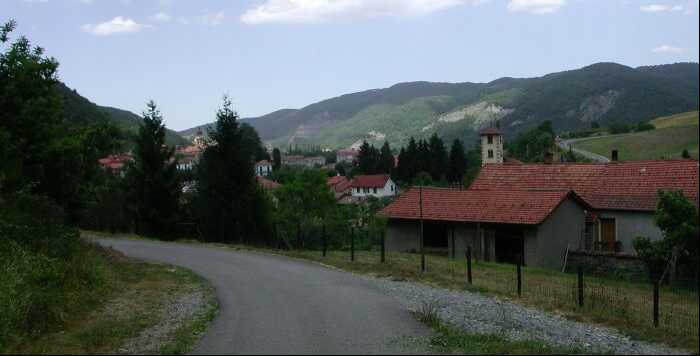 |
|
|
|
|
|
In '700 the town developed along the street between
the church and the bridge, to the Capuchin monastery. They were erected
tall buildings, like all the "major Genoese brothers" (Ceschi, De Negri,
Gabrielli, 1965). Watch the ancient palace inhabited by the Duchess of
Galliera and Casa Scorza, Battilana nowadays. By a casually observe, you
feel the sensation of being in Via Garibaldi, in the presence of one of
the giants of post-Alessian stone architecture. In the palace of the
Duchess, the big windows of the ground floor, protected by railings,
form a single plea with the portal; bright atrium ascend to the main
floor, where you find very large windows. In Scorza palace, remodeled
unfortunately at the end of 800, the Genoese architecture lends itself
to more practical and functional solutions, but the reason for the
triple order of loggette superimposed, open on the side towards the
church no other windows in the vicinity (in the origin sun openings on
this hiatus were the lodges), to give the same breath and most important,
it was a happy and aristocratic architectural solution. In the inner
garden is the workroom of Sinibaldo Scorza. |
|
|
|
|
|
At the beginning of the '600 dates the founding of
the Capuchin convent. Built on a promontory called 'Tenda', the
Voltaggio's convent is the first monument that is presented to those
coming from theBocchetta pass or steping down from the Castagnola. |
|
|
|
|
|
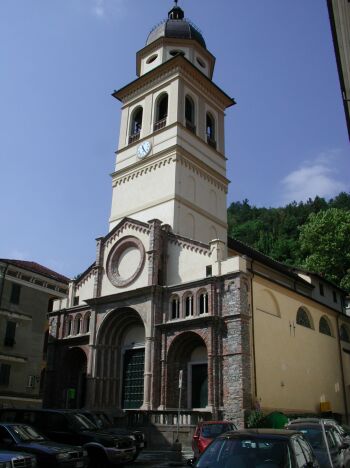 |
|
|
|
|
|
The interior of the church immediately brings to
mind the simplicity of a dear Franciscan sanctuary to the Genoese, the
Holy Father; but you do not be fooled by the simplicity of the lines and
style of the church apparently unadorned. The large blade with Madonna
and Santi Gian Battista Paggi on the left wall, the canvas with the
saints Paolo eremita and Antonio abate, above the left input, together
with the wooden Madonna, that the Society of Voltaggio Rosario acquired
in 1716 by the workshop Maragliano of lire in 1500, now is in the
Capuchin church to be restored, turn the spirit of tourists to enjoy
other masterpieces.
|
|
|
|
|
|
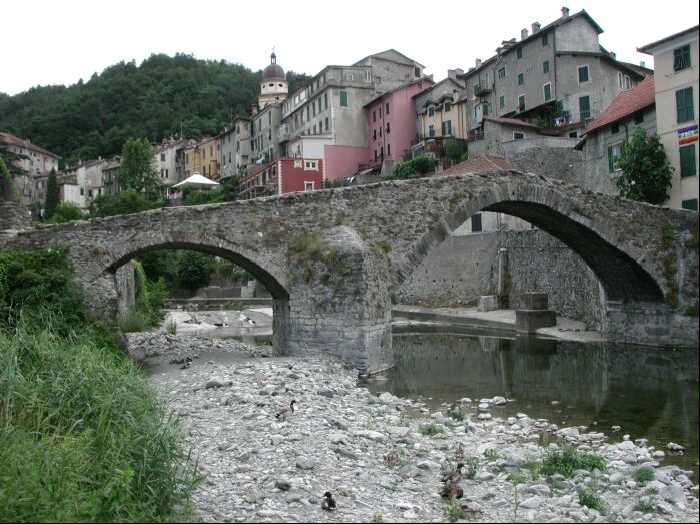 |
|
|
|
|
|
In the convent, in fact, gathered last century by
Father Pietro da Voltaggio in forty years of research, is an original
collection of works of art, partially exposed to the public, for the
initiative of Father Ugolino and a committee led by mayor of Voltaggio.
The restoration of the paintings was edited by the Superintendence of
Galleries of Piedmont. |
|
|
|
|
|
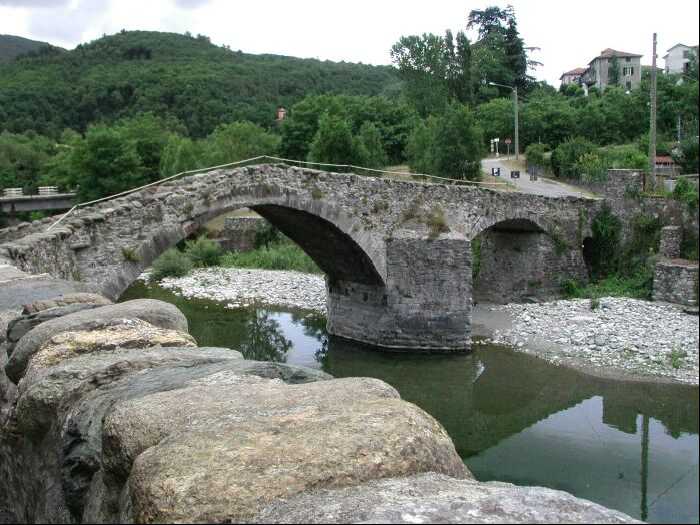 |
|
|
|
|
|
If you enter the gallery by a small porch that opens
onto the square. In the lobby there is a beautiful wooden statue of St.
Francis of the first seven hundred Genoese and on the right is the
entrance to the first room, where paintings are sorted by Bernardo
Strozzi, Giovanni Andrea De Ferrari and G. B. Merano. In the second room
you can see other paintings, including, on the back wall, Christ
comforted by angels of Sinibaldo Scorza, valuable for live naturalism of
landscapes. In the two rooms were recently temporarily accommodated
other paintings, result of the most recent renovations: the renovation
of the first floor, in the Committee's programs, will allow proper
public display of the remaining part of this large artistic heritage. |
|
|
|
|
|
The Voltaggio's Gallery, deserves a special trip
from Genoa and also from further afield. Is surprising to find among
these hills a treasure of so significant works of the greatest painters
of the Genoese, and not just the Genoese, from '500 to' 700. They were
placed in the environment into which the admiration of the public and
the interest of scholars were collected and retrieved with the
adaptation of the two wings of the nineteenth-century convent on the
ground floor, and no external lines of the monument has been altered.
|
|
|
|
|
|
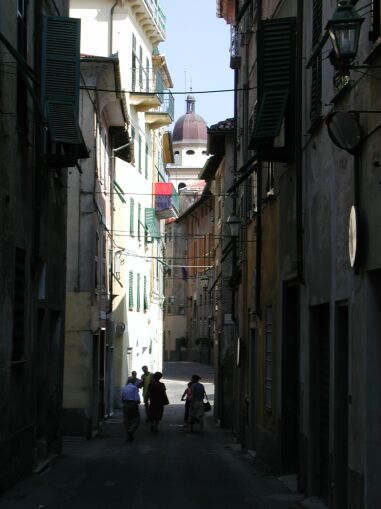 |
|
|
|
|
|
The monastery is therefore an anchor for those
arriving in Voltaggio in search of fresh air and news, but the country
remained unchanged since, in 1823, the way of the Scrivia valley, open
at the time of the House of Savoy, took off to Vallemme the primacy of
trade and commerce, this can also be a welcome surprise. You have to get
there, it is true, willing to breathe a climate a bit austere, in a
shady village, frequented by a middle class that moved up here to have a
discreet way of living and a certain privacy. But it is not so difficult
to get to the heart of this reality, if it will happen you come to
Voltaggio one day in the late summer, when the shadows lengthen and the
country returns to gather around his palaces and the common walls of the
houses, each leaning against the others like to be more warm with the
arrival of the autumn. Better to enter from the extreme limit of
Voltaggio from the side of Carrosio. Here, in S. Nazaro, near a well
that still exists today and is visited every year, to commemorate an
event by the brotherhood of St. Giovanni Battista; it is said that the
saints Nazario and Celso have converted and baptized the inhabitants
still pagan di Voltaggio. Nearby is the oratory of St. John, a lovely
nineteenth century building rectangular in plan, with wide and bright
interior dome that houses the beautiful canvas of the Immaculate
Sinibaldo Scorza and an eighteenth-century wooden Madonna of exquisite
workmanship.
|
|
|
|
|
|
Continuing along the main street, as well as one of
those characteristic passages between palace to palace as in the
old Genoa, you enter in the hospital area, where stands the chapel of S.
Sebastiano, long ago fallen into disuse. |
|
|
|
|
|
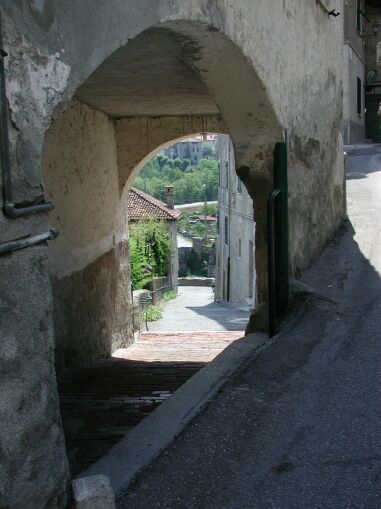
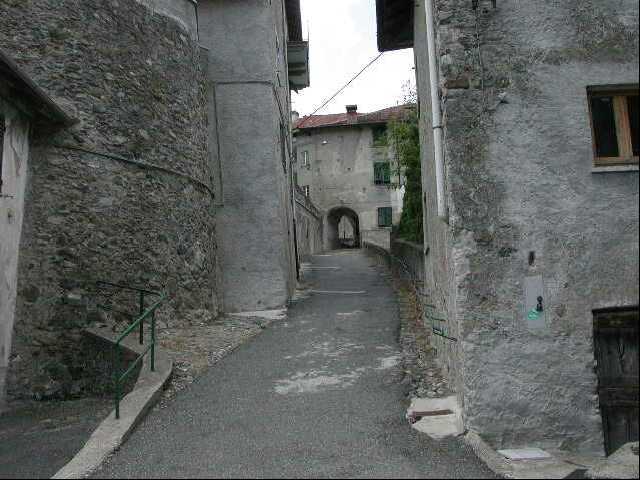 |
|
|
|
|
|
The church, abandoned to
the damage of the bad weather and the men, is now reduced to squalid
dump, is a fine example of Baroque architecture with Genoese and some
Lombard influence. Who designed it, in the years around 1750, he had to
know his stuff, if the relationship of two American scholars, "Clemson
University Center for researche building & Urban Studies" revealed that
the building was designed on the basis of three palms Genoese measures
and the form used for architectural parts was strictly repeated in the
decorative and functional elements such as pilasters, the projecting
cornices, windows, and altars. The result was an amazing building, in
which proportions and relations between areas and volumes are absolutely
perfect. For these reasons, the Oratory of S. Sebastiano should be
recovered as soon as possible to the public enjoyment and used with
acoustic definitely appreciable results, given the strict volume setting,
as musical audition room. When the original building would be renovated
according to the Clemson University project, the beautiful painting of
S. Sebastiano tended by the Holy Women of Domenico Fiasella returned to
stand out in the apse and in the hall could hold concerts, Voltaggio
would add to what already has another tourist attraction for sure
success and would return to the community a little architectural gem.
|
|
|
|
|
|
After crossing the bridge, right after a large car
park, very close, appear the fifteenth-century house of Grimaldi the
aforementioned, and the sulfur-water spring. Start in this place the
Morsone valley, crossed by a road that more or less following the course
of the stream or climbing on the foothills of Mount Tobbio, goes to join
on the coast of Ermitti with the one coming from Bosio and continues for
Capanne di Macarolo (Marcarolo's huts). Of this road will be discussed
at the time, let's back in the main street. After a steep ascent, you
arrive on the church square. The plant hydrotherapy, now converted into
a hotel, gives the place a touch of belle époque, but the houses stand
very high and strict, and all above the bulk the bell tower posed as a
tower on the pediment of the church. As a tower, including the
fortifications around the castle, it might really be, since the
Voltaggio's church suffered, over the centuries, several reconstructions.
The last, in 1886, has changed the appearance and architectural
structures with the transfer of the doorways where once was the apse. So
the tower stood in its place, but it found itself on the front instead
of the ends of the choir. That's why dominates imposing on the pitch,
just like an ancient watchtower.
|
|
|
|
|
|
The interior has three aisles, bright and austere
houses early works of Sinibaldo Scorza, a Voltaggio's beloved artist.
He's attributed unconditionally not only the paintings of the parish
church, the sacristy, the Oratory of St. Giovanni Battista and finally
the monastery, but also small frescoes on the facades of rustic
scattered in the countryside and in the woods around the country,
because Scorza, along with "recheuto of Voltaggio" ingredient of no
small weight in "The Christmas round "sung by Niccolò Bacigalupo, was
great pride of this land, that as illustrious and good things men, was
not at all stingy . And while from the pictures we switched to more
mundane topics, but no less remarkable if we look today this territory
with the eye disenchanted of people turned into robots by convulsions of
everyday life. |
|
|
|
|
|
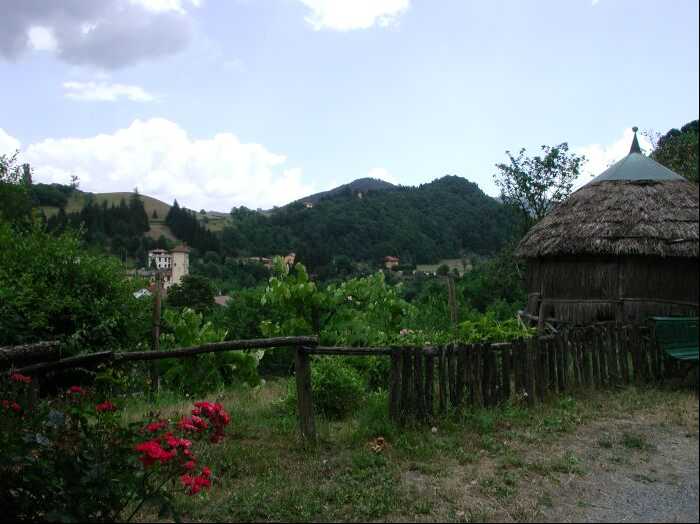 |
|
|
|
|
|
Its narrow winding streets, his "gut": a kind of
umbilical cord, along which line up the oratory of the Nativity, with
frescoes and leached pale façade of the palace of the Duchess, the house
that was of the great painter, of which we read in the "Lives of the
Genoese painters" of Sopranos, that the Duke of Savoy, waging war to the
Republic in 1625, having seized after much blood Voltaggio put it
on fire, concerning only about the houses and properties of Scorza,
whose service and value, kept the memory alive ; all the urban part of
the town, in short, should be savored after dark, in the light of old
style street lamps. |
|
|
|
|
|
The reality seems then transformed; can evoke the
past ghosts, the Duchess back for a moment on the open carriage in "her"
Voltaggio and the Beach Club back to crowd every day in the beautiful
swimming season, a hundred-twenty languishing, (at seven Lire a day)
hopeful of beneficial effects of the copious pool of sulphurous water "(Remondini,
1891). |
|
|
|
|
|
The witty Andrea Grasso proposed canon, to the 800,
the dedication of this written to Dr Romanengo which was the
creator of the Spa: TU LIMPHAS AEGRO, NUMMOS TIBI PORRIGIT AEGER, TU
CURAS MORBOSILLIUS,ILLE TUUM... (you offer to the invalid water
and he will pour his money; you cure his illness, he your ...).
|
|
|
|
|
|
The reality is perhaps another. The countryside
around the village, now deserted, no longer produce the famous ricotta,
so sought after by the Genoese for Christmas lunch, and the undergrowth
accumulate grass and dry leaves, preparing the way to fires; upstream of
the quarry of Cementir has pierced the mountain, making it similar to a
flounce of Purgatory, from the hips plagued by excavators. Another
quarry threatens the high Lemmevalley, over the mountain pass of the
Bocchetta, one of the most scenically interesting points of the area of
Tobbio; the Lemme flowing yellowish for the waste of the paper mill.
The only real industrial resource, the textile mill, built in 800, is
closed for some time and the bodies of the building have been
transformed, in a discreet way in housing. But tourism, tourism not only
seasonal and elite, thanks to scrupulous action for the protection of
environmental and cultural resources, carried out with courage and
clarity of ideas by the present administration, thanks to Asseretos, to
Fiasella, to Cambiaso, Strozzi restored that in the convent does not
cease to be admired, to the surroundings of a green and an unrivaled
amenities, it can still become active and vital.
|
|
|
|
|
|
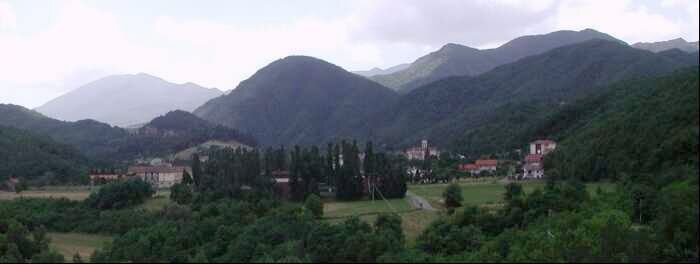 |
|
|
|
|
|
Diverse and beautiful are the Voltagio's
destinations, all listed in the valuable guidance of the FIE. |
|
|
Le montagne
importanti sono il Tobbio, splendida per le sue rocce serpentinose e la
selvatichezza dei manto verde, il Leco, le Figne, e, sul versante est, il
monte Zuccaro. The important mountains are Mount
Tobbio, stunning for its serpentine rocks and the wildness of the green
mantle, Mount Leco, the Figne, and on the east side, Mount Zuccaro. |
|
|
Among all the excursion; the one to the top of Monte Tobbio (m. 1092).
|
|
|
II trail signboard consists of a yellow triangle
full and the trail starts at the beginning of the town, at the Oratory
of St. Anthony, rises to the coast and continues through chestnuts and
oaks forests up to Cravara coast, where it meets a source. The mountain
can be reached along the valley of the Morsone, to the pass of Ermitti.
The summit is reached in one hour. Rarely is given to hikers to enjoy a
panorama like the one offered by Tobbio: in a clear day you can admire
from up there the whole plain of Alessandria, Monferrato, the Apennines
chain to the distant Mount Penna, the circle of the Alps, from the
Maritime to the tops of Valle d'Aosta.
|
|
|
|
|
|
In addition to the usual and consecrated customary
routes, the area around Voltaggio offers many other occasions, even in
winter, to stretch your legs and go in search of new destinations to
discover solitary valleys, where silence and the contact with nature are
absolute. We cite particularly two valleys: dell'Acquastriata and Rio
Lavaggetta, one in the area of Voltaggio-Molini, on the left bank
of the Lemme, and area of Lagoscuro that leads on the watershed of
Casa Carrossina. The other at the foot of Mount Tobbio, several trails
climb through the woods, following the curves of the streams, immersed
in the trees and reappear in sections in the open, in the midst of rock
debris, in an increasingly diverse scenery utterly peaceful and resting. |
|
|
 |
|